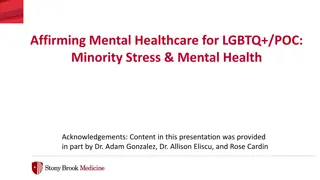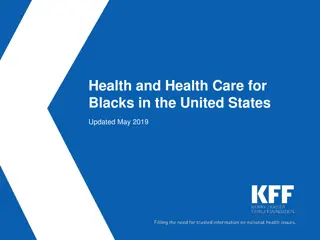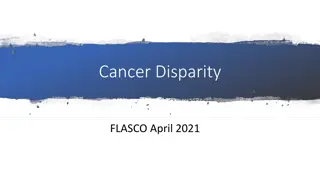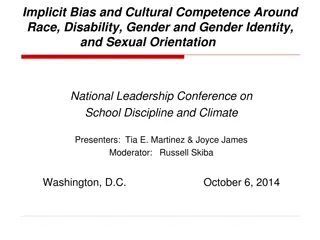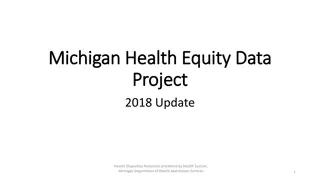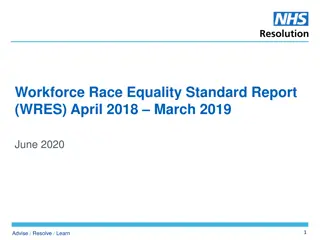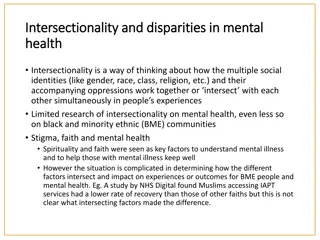Challenges and Disparities in Minority Health and Workforce
The content discusses the challenges faced by minorities in health care settings, focusing on the impact of COVID-19 and disparities within the workforce. It highlights the importance of addressing social determinants of health, such as economic inequalities and racial disparities, to ensure holistic recovery for minorities. The data presented sheds light on the inequities faced by women of color in direct care and early childhood education. The Economic Policy Institute's report emphasizes the disproportionate impact of COVID-19 on black workers, with high rates of unemployment and economic vulnerability.
Download Presentation

Please find below an Image/Link to download the presentation.
The content on the website is provided AS IS for your information and personal use only. It may not be sold, licensed, or shared on other websites without obtaining consent from the author.If you encounter any issues during the download, it is possible that the publisher has removed the file from their server.
You are allowed to download the files provided on this website for personal or commercial use, subject to the condition that they are used lawfully. All files are the property of their respective owners.
The content on the website is provided AS IS for your information and personal use only. It may not be sold, licensed, or shared on other websites without obtaining consent from the author.
E N D
Presentation Transcript
Minority Health Strike Force Town Hall Meeting Friday, June 5, 2020 Teresa L. Kobelt, MSW, LSW Director Strategy, Innovation, Forecasting
Minority Health Strike Force Stop the progression of the disease. Evaluate and document the impact of the disease. Remedy factors that contribute to the spread. Procure resources to prevent a resurgence of COVID-19. CONSIDERATION: Disparities exist in recovery. Efforts to evaluate and document the impact of the disease should include short and long-term impacts with a focus on social determinants of health. KEY QUESTION: Are minorities recovering in every sense of the word? COVID-19 Minority Health Strike Force: Interim Report https://coronavirus.ohio.gov/static/MHSF/COVID-19- SFR.pdf
Workforce Direct Care Women of color make up largest, fastest-growing segment of direct care workforce From 2005 to 2015, women of color in direct care grew from 45 percent of the workforce (1.2 million workers) to 48 percent (1.7 million workers). From 2016 to 2026, the number of women of color in the labor force is projected to grow by 6.3 million workers, while the number of white women in the labor force is projected to decline by 384,000 over the same time period The poverty rate for women of color in direct care is higher than any other group 22% Forty-nine percent of women of color in direct care rely on public assistance PHI Issue Brief: Racial and Gender Disparities Within the Direct Care Workforce: Five Key Findings: https://phinational.org/wp- content/uploads/2017/11/Racial-and-Gender-Disparities-in-DCW-PHI-2017.pdf
Workforce Early Care About 40% of early care workers are people of color. By comparison, 80% of K-12 teachers are white. Center-based African American early educators are more likely to earn less than all other racial/ethnic groups in the early education workforce nationwide. Even after controlling for educational attainment, African American workers still earn lower wages than white workers ($0.78 less per hour, or $1,622.40 less per year, for a full-time, full-year worker). Early Childhood Workforce Index 2018: https://cscce.berkeley.edu/files/2018/06/2-About-the-Workforce.pdf
Workforce Economic Policy Institute. https://www.epi.org/publication/black-workers-covid/
Workforce Employment Participation & Unemployment As of April, less than half the adult black population was employed (employment to population ratio). "Black workers are less able to weather such a storm because they have fewer earners in their families, lower incomes, and lower liquid wealth than white workers. Black women have experienced the highest rates of unemployment and the lowest rates of employment (two different measures) Economic Policy Institute. https://www.epi.org/publication/black-workers-covid/
Recommendations Include recommendations that focus on the long-term impacts of the disease. Screening, testing, tracing AND recovering (educationally, economically, medically ). To what extent are minorities returning to the workforce? To what extent are minorities returning to educational environments? To what extent have minorities recovered as measured by (work with communities of color to define recovery)? Recommendation #1: Recognize the contributions of minorities to front-line industries. Track and report (by race) unemployment, reemployment and/or employment participation in industries where minorities represent large portions of the workforce (i.e., direct care, early childhood). Leverage these worksites for screening, testing, education and outreach, and input. Recommendation #2: Report on the number of minorities that have not had access to programs and services that directly impact social determinants of health (i.e., Head Start, School Lunch, etc.), prioritize such programs for restart/recovery, and track minorities return to these programs/services. Leverage these for screening, testing, education and outreach, and input.





